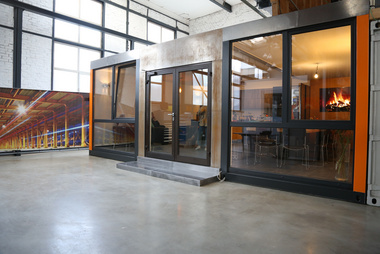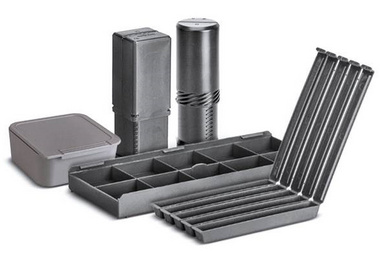Solid carbide drills
Solid carbide drills can be regrinded several times and can therefore be used economically in the diameter range from 6.8 mm to 20 mm when used in steel construction. However, we recommend solid carbide drills exclusively for modern drilling rigs with stable material tension, high speeds from 2500 rpm and high drive power, because the carbide material has a very high wear resistance (hardness), but a lower toughness than HSS tool steels and is therefore more sensitive to improper use than normal HSS coolant channel drills or interchangeable plate drills.
With us you can buy solid carbide drills from Hartner at fair prices. The usual standard designs 3xD, 5xD and 7xD you can in the diameters from 6.8mm to 20mm in the following uncomplicated request and order from us.
Special designs are also available on request.
Solid carbide drills from Hartner at low prices
The solid carbide drills comply with DIN 6537. They have fire coating, cooling channel, HE clamping surface, right cutting direction, point angle 140 degrees with 2 surface grinding and a diameter tolerance m7.
Application areas and limits of the use of solid carbide drills.
Hartner solid carbide drills have a modern Fire coating. The extremely thin Fire coating is a TiAlN/TiN multilayer coating. It increases the wear resistance and thermal load capacity of the carbide. You can recognize the Fire coating on our carbide drills by the purple color.
Solid carbide drills in use on modern plate machining centers
Due to their extremely high wear resistance, solid carbide drills made of the composite material carbide offer very high cutting performance even without a special coating. However, by coating the solid carbide drills, these already very good wear values can be significantly improved even further.
In the video you can see some examples of the use of solid carbide drills for drilling flat steel and sheet metal. The Kaltenbach KF2506 and Voortman V320 flat steel drilling units or sheet metal processing centers shown in the video have the appropriate stability and correspondingly high drive power with high drill speed, high feed rate and torque. Only with these high-performance drilling units can the drilling performance of the solid carbide drills also be exploited economically.
Where are the limits of carbide drills?
From a drill diameter of approx. 20mm, the use of carbide drills with replaceable carbide cutting body makes more economic sense. As a machine and tool specialist, we can of course also offer you modular drilling systems with exchangeable tool cutting edges:
- Hartner Multiplex interchangeable insert system
- Kennametal KSEM Modular Drill System
The Hartner Multiplex carbide cutting edges and Kennametal KSEM are screwed into a tool holder and replaced when worn. However, these carbide cutting bodies have limited regrindability and are therefore not sent for regrinding by most machine users.
Häufige Fragen zum Thema "Vollhartmetall-Bohrer"
Was bedeutet "VHM Bohrer"?
"VHM Bohrer" wird synonym bzw. als Acronym für "Vollhartmetall-Bohrer" genutzt und ist aufgrund der kürzeren Schreibweise ein üblicher Begriff in der Stahlbau-Branche. Beide Begriffe beschreiben einen Bohrer der komplett aus dem Werkstoff Vollhartmetall gefertigt ist.
Was ist ein Vollhartmetall-Bohrer?
Vollhartmetall ist ein spezieller Verbundwerkstoff, der u.A. für Werkzeuge genutzt wird, die für extreme Bedingungen ausgelegt sind. Das Metall wird mit sog. Hartstoffen versehen, wodurch eine höhere Härte, Zähigkeit und somit eine optimale Standzeit der Bohrer erreicht wird. Die Härte des Werkstoffs ist nötig, um Metalle wie z.B. gehärteten Stahl überhaupt bohren zu können. Ein weiterer Vorteil ist die Reduktion der Reibung beim Bohren. Vollhartmetallbohrer werden mit sehr hoher Drehzahl in Kombination mit entsprechendem Vorschub eingesetzt, um bei der Anwendung die optimale Bohrungsqualität zu erreichen. Der Nachteil von Vollhartmetall ist eine erhöhte Bruchempflindlichkeit. Aus diesem Grund sollten Vollhartmetall-Bohrer ausschließlich mit entsprechend ausgelegten Bohr-Anlagen betrieben werden.
Worin unterscheidet sich ein Vollhartmetall-Bohrer zu einem HSS-Bohrer?
Der Unterschied liegt im Wesentlichen im verwendeten Werkstoff. Ein HSS-Bohrer besteht aus "Hochgeschwindigkeitsstahl" (High Speed Steel). Der Vollhartmetall-Bohrer ist jedoch härter und verfügt über optimale Leistungsparameter für das Bohren auf professionellen Bohranlagen.
 Deutsch
Deutsch  English
English  Polska
Polska  Nederlands
Nederlands  Français
Français  Español
Español 





